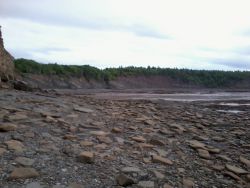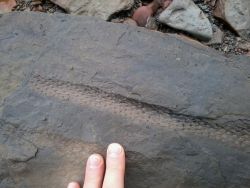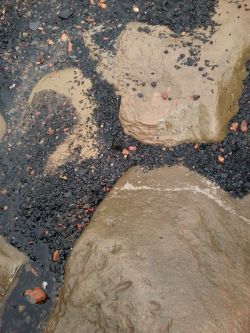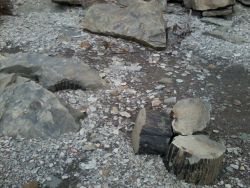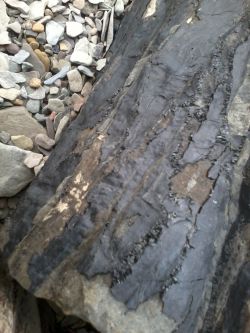Halifax Media Co-op
News from Nova Scotia's Grassroots
Joggins and Carbon Farming: sequestration in prehistory and how we can do it today
I visited the fossil cliffs at Joggins last week, a nice day-trip three hours out of Halifax, likely a school trip remembered by native Maritimers with boredom and dread but a novel destination for this nerdy Ontario girl.
I naively wondered what era of the world these famous cliffs represented, forgetting Nova Scotia's coal industry, her coal disasters, our coal-powered electricity plants, and each old coal scuttle I've found in every garden I've worked at in this city. Could it have been, I don't know, the coal age? That still smarts!
I asked if the museum had seen an influx of tourism due to being featured by Neil Degrasse Tyson on Cosmos. They hadn' t known about that reference and they said not yet. Tyson spoke of the role the carbon cycle plays in both geology and the world's climate, as carbon moves from the sky to the rocks and back again.
Lepidodendron was an early tree, resembling giant club mosses, and these make up the bulk of the fossils on the beach, along with Dendrerpeton, an early reptile that was one of the first animals to be able to breed on land. Displays at the museum show that scientists think the giant moss tree grew quickly and was not very substantial. (The coal seemed only to have been made from the outer skin of the moss, the core filling with silt. I could only imagine how many of these trees would have to be pressed to make even a tonne of coal).
Fast Carbon Pathways
There are some plants that grow in this way today, living fast and dying young. Japanese knotweed is one. 'Weedy' trees like poplar or Manitoba maple are others. At Verge Permaculture they called these sorts of plants fast carbon pathways, in that they are a fast pathway for carbon go to from the atmosphere as CO2 into the ground as a solid carbon mineral, whether that's as humus or eventually coal.
Fast carbon pathway plants tend to be early-successional , which means that they're first on the scene when a piece of land is cleared, and then give way to slower-growing, more long-lived plants when the landscape is further matured toward forest. Their role in the ecosystem is to raise levels of soil-carbon quickly, and they exist all over the world. In the case of the Carboniferous Era, the moss-trees were early-successional in an evolutionary sense, giving way to slower-growing more long lived plants when more complex plant life emerged.
Scientists think one reason the Coal Age removed so much carbon from the atmosphere was that wood-digesting fungi had not yet evolved 1. Nowadays we have sapprophytic fungi; mushrooms with the enzyme lignase that can digest wood, gain energy and release that carbon again. If there are not humans around burning coal, this is not a problem.
However all is not lost, humus is a great stable way to store carbon 2. Humus is a category of matter that is the end-product of decomposition. It's made out of carbon, is great for holding onto water and nutrients for your plants, and decays only very slowly, building up into a rich soil over time. You can build fertility and sequester carbon in your own garden using no-till methods, by growing perennials, composting, root-pruning, and chopping-and-dropping. Even grazing animals can be used to sequester carbon in the soil.3
Carbon Farming
Carbon farming is a new, vast and growing field, one that I hope to learn more about in future. Keep an eye out for Eric Toensmeier's upcoming book Carbon Farming: A Global Toolkit for Stabilizing the Climate with Tree Crops and Regenerative Agriculture Practices" which is estimated to come out next year, 2015.
And carbon farming is just starting to enter public policy. The Australian government has instituted a program facilitating Voluntary carbon credits, linking up carbon-sequestering farmers and companies who want to support them. The United States is also working toward making it sustainable for foarmers to provide those services we usually take for granted. The USDA has created a new department for Ecosystem Services and Markets, designed to help farmers providing "free" services such as water and air purification, views, wildlife habitat and carbon storage. From their website, the Office aims to "provide administrative and technical assistance ... in developing the uniform guidelines and tools needed to create and expand markets for these vital ecosystem services"
Marin Organics are a farm in California is generating tools that the American state can use to adhere to its Assembly Bill 32, which aims to reduce greenhouse gas emissions 30% below 1990 levels by 2020 and by 80 percent by 2050. these tools include carbon audits, voluntary carbon credits, labelling for carbon-neutral and negative-carbon foods. And because artificial pesticides an fertilizers burn up soil carbon, releasing it into the atmosphere, carbon incentives also encourage organic farming, providing further benefits to our air, water and biosphere.
The carbon storage potential of humus in the soil is huge. Writes Australian author Allan Yeomans;
“If the organic matter in the top foot of all the world’s field and pasture soils were increased by 1.6%, the greenhouse effect would be back to near normal.”
1 (Cosmos season 1 ep. 9, May 3, 2014)
2 (Growing Gaia's Garden, pp 77, 91)
3 (Michael Pollan, The Omnivore's Dilemma, p156)
The site for the Halifax local of The Media Co-op has been archived and will no longer be updated. Please visit the main Media Co-op website to learn more about the organization.
